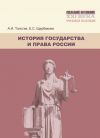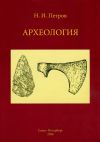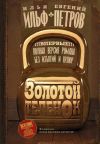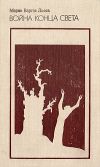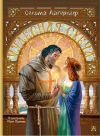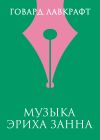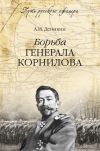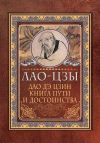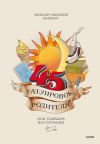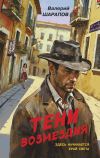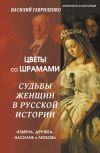Текст книги "Glimpses of Britain. Учебное пособие"
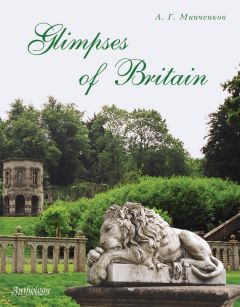
Автор книги: Алексей Минченков
Жанр: Иностранные языки, Наука и Образование
Возрастные ограничения: +12
сообщить о неприемлемом содержимом
Текущая страница: 2 (всего у книги 15 страниц) [доступный отрывок для чтения: 5 страниц]
The House of Normandy
As soon as it became clear that the king’s initial desire to work with the old Anglo-Saxon aristocracy had failed, he set out to create a new йlite that would be loyal to him and ensure his position as king of England. That was secured by two things: castles, and knights to man them. The most famous of all the castles was the Tower of London. William I organized the government of England on the system that had been successful in Normandy – the feudal system based on the ownership of land. He granted lands confiscated from the defeated aristocracy to 170 of his followers who became thereby his tenants-in-chief. The grants of land were usually scattered through several shires. Collectively each group of lands was called an honour and each honour consisted of several smaller units called manors, divided among the 5,000 knights who had fought at Hastings. A knight had to swear loyalty to his lord. Each tenant-in-chief had 2 groups of knights: one consisting of those who were permanently part of his household and a second one including those who came in return for land. The lords themselves had to swear loyalty to the king and to supply knights for his service. The common people belonged to the knight on whose manor they lived. They had to serve as farm-workers but not as soldiers. There was also a small class of freemen, who didn’t have to work on the knight’s farm. William was a strong king and the system worked. The trouble was that under a weaker ruler the system could break down, leading to private castles and armies.

The White Tower in the Tower of London
The same revolution was applied to the Anglo-Saxon church. In Normandy William controlled all the appointments of bishops and abbots, filling them with his own friends and relations. Bishops and abbots from before 1066 either died or were deposed. They were replaced by Normans, and had to render the king rent in the form of armed knights. Together the tenants-in-chief, bishops and abbots made up the new ruling class, for the higher clergy, being educated, were essential for the running of the government. In these changes William was aided by a new archbishop of Canterbury, Lanfranc. Both believed that priests should be celibate. More significant for the future was the creation of special courts to deal with church cases only.
All the lords had the right to attend the king’s council and it was his duty to ask their advice. William held council meetings nearly every day, wherever he happened to be. Three times a year he held a ceremonial council for Christian feasts and wore his crown: in Winchester for Easter, in London for Whitsun and in Gloucester for Christmas. Then every lord had to attend.
Winchester castle was still the seat of Government. Here William set up his government office, which controlled the collection of taxes and kept account of all expenses. From this office men were sent out in 1086 to make a detailed record of all the wealth of England, for William, fearing invasion from Denmark, wanted to extract the maximum in taxation. The result was the Domesday Book, which gives us a complete description of the country. The book occupies 400 double-sided pages and paints a picture of a country where virtually the entire population was engaged in agriculture with little or no industry or commerce, and few towns.
William’s reign saw a wave of new building in the beautiful style called Norman or Romanesque. The Romanesque style was fully developed by about 1100, becoming the accepted style for church buildings throughout Europe, with marked regional variations. In England, soon after the Norman Conquest work began on the Cathedrals of Canterbury, Lincoln and Winchester [12], and the churches of St. Albans, Ely and Worcester. However, only parts of these buildings have survived: they were all largely rebuilt in the 12th – 14th centuries. The finest Norman building to survive in England is Durham Cathedral, begun in 1093 and completed in 1133. [7] The style made use of massively thick walls, huge columns and lofty vaults. There were small windows and doors. The round arch became established as the basis of the church interior. [9] Some of the churches were indeed very ornate, with decorated pillars and carved doorways.
As for domestic architecture, there were manor houses and castles. In early Norman England the hall, together with a few out-buildings about a courtyard constituted the entire accommodation of the manor house. The first castles had a mound or motte [6] (in modern England remains of more than 3,000 Norman mounds can be found) with a single defensive four-storey tower and a bailey, that is a fortified outer wall initially made of wood and later of stone. The most famous of the early Norman towers is the White Tower of London begun in 1078. Slightly later came circular shell-keeps like that at Windsor Castle. In the mid-12th century this style changed under the influence of the Crusades. A fine example of the new style is Conisborough Castle built about 1180 (used as a setting for the film based on Ivanhoe by W.Scott). The tower or the keep was retained as a lordly residence. [14] This was surrounded with a stone curtain wall with solid half-round towers along its length. Rings of concentric defenses were to be the future of the castle form. [13] By the second half of the 12th century the castle had already become primarily a domestic residence, but with built-in precautions for protection against social unrest.
For the invaders the conquest of England was a remarkable achievement, and enduring at that. For the native population it was a cruel and humiliating defeat which swept their civilization away. The new aristocracy saw its first loyalty not to the land they had conquered but to Normandy. For four centuries to come English kings were also to be continental rulers, and the wealth of England was expended in wars aimed at acquiring, defending and sustaining a mainland empire.
The state which William I created called for strong kings. Fortunately he was succeeded by two of his sons who were just such men, but disaster was to strike later when his grandson seized the throne. The crown passed first to the king’s second son, William Rufus, next to his fourth son Henry I, and finally to his grandson, Stephen. Stephen was a weak king, so the result was anarchy. Some of the barons went over to Matilda, the daughter of Henry I, others were loyal to Stephen. Worse, the barons began to fight private wars with each other.
Medieval England
Before his death in 1154 Stephen adopted Henry, Matilda’s son, as his heir. Henry’s father was Geoffrey Plantagenet, Count of Anjou, Matilda’s second husband, and his wife was Eleanor from Aquitaine. So, when he came to the thrown as Henry II (1154–1189) he held an enormous empire including England, Normandy, Brittany, Anjou and Aquitaine, and called the Angevin Empire. Henry II was the first of 13 Plantagenet kings who were to rule England for 300 years. He was universally respected as a just and wise king. He was the first literate king after the Conquest, being able both to read and write. Henry set out to restore the power of the crown and in so doing laid the foundations of a system of government that was to last for centuries. These developments came about partly because the king, having always to be on the move, needed to leave officers he could trust behind him. So successful was he in the case of England that he was able to absent himself for several years at a time, and yet order and justice were maintained. Castles illegally constructed by the barons were demolished and replaced by manor-houses. A knight’s feudal service of 40 days was of little use to Henry, who needed regular soldiers to guard his French possessions. He encouraged his lords to pay a special tax instead of sending him their knights. This allowed him to hire professional soldiers, while the knights remained at home and improved their manors.
Henry II is best remembered for his reform of the courts and the system of law. He sent out his own judges to make regular tours of the country, and any freeman could take a case to them if he didn’t trust the local courts. Most important was Henry’s jury system. In Henry’s times the jurors were witnesses themselves, and no man could be tried unless a jury of 12 men swore that there was a true case against him. This was real progress. In England now there are two kinds of law: statute law, that is Acts made by Parliament, and common law. Common law was first collected together by Henry II. It reflects the changing customs of the land which have been expressed in court judgments through the ages. Henry believed so strongly in the rule of law that he kept no army in England, but laid down the exact weapons and armour that every free man should hold ready for the defence of his country.
What proved a real problem was the king’s relationship with the church and the man who was to become first his chancellor and then his Archbishop of Canterbury, Thomas Becket. Many practices of the church courts were an insult to Henry’s rule of law, for they often let even murderers go unpunished. Besides, by the close of the 11th century, the church was undergoing a revolution, asserting the dignity of the priestly office and the power of the popes as direct successors of Christ through St. Peter. The Anglo-Saxon and the Norman church had been at the service of the state. The kings were sacred beings and appointed both bishops and abbots. The king presented them on appointment with a staff and a ring, symbols of their office. The staff, called a crozier, symbolized their role as the shepherd of their flock. They then did homage to the king and received their lands. The struggle to separate the church from the control of the state was to become focused on the one act of the king giving the office holder his staff and ring. In the reign of Henry I a compromise was reached: the king no longer gave the cleric his ring and staff but retained the right to receive his homage. But neither side was happy.
The story of the conflict between Henry II and Thomas Becket, which probably has not only a political but an important human dimension, being also a conflict between personal loyalty and personal convictions, is so dramatic that it served as a source of inspiration for two famous writers, one of whom, the French dramatist Jean Anouilh wrote a play called Becket (1959), and the other, T.S.Eliot, made a verse play Murder in the Cathedral (1935).
The struggle between the church and the state reached a crisis in the reign of Henry II. When the king came to the throne he appointed Thomas Becket to the major administrative post of chancellor. Becket and the king became great friends. In Becket the king saw a means of tidying up relations between church and state. He believed that with his friend as Archbishop of Canterbury the situation could return to how it had been just after the Conquest. In 1161 the opportunity came with the death of the archbishop. On 2 June 1162 Becket was ordained priest and on the following day appointed Archbishop of Canterbury. After that he immediately resigned all his secular offices and changed his style of life to self-denial and humility. Henry, however, failed to recognize that times had changed and his old friend had been trained in the new canon law in which the clergy were exempt from lay interference. Henry decided that criminal clerks must in future be tried by lay courts, for in a church court the worst sentence was to defrock the clerk. Public opinion supported the king and most bishops agreed, but Thomas refused and fled abroad. For 6 years there followed endless attempts to bring about a reconciliation. In July 1170 Becket returned to England. His first act was to excommunicate all the bishops who had taken part in the coronation of Henry’s son as successor in Becket’s absence. The king was seized with fury, crying in an unguarded moment ‘Who will rid me of this low-born priest?’ In all too eager response four knights slipped out of the room, set sail for Kent and on 29 December murdered the archbishop in his own cathedral.
Becket’s tomb in the crypt of Canterbury Cathedral [21] became a shrine at which miracles occurred and soon after, in 1173, the pope canonized him. Canterbury swiftly became the most popular centre of pilgrimage in medieval England. The king himself did penance walking barefoot through the streets of Canterbury and after that gave himself over to being flogged by his bishops and monks. Yet, Henry’s inheritance was splendid: good government in terms of peace, law and order on a scale unknown to any other country in Western Europe at the time.
Nothing is more striking than the stability of England at the time of Henry’s death. So strong was the government that it could withstand the fact that the next king, Richard I, who ruled for a decade (1189–1199), only visited the country twice, once for three months, and a second time only for two. He was dubbed Coeur de Lion or Lion-Hearted, in tribute to his dare-devil bravery; England was looked upon as little more than a source for money to pay for the crusade on which he embarked. When Richard was killed the Angevin Empire passed to John.
This time it was a far from glorious legacy: war with an increasingly powerful French king, financial crisis in England caused by the wars, as well as the late king’s crusade and ransom money. Whatever Richard’s shortcomings, he had been respected and evoked loyalty. No one quite trusted John (1199–1216), who had been nicknamed Lackland by his father.
Normandy, Anjou and Brittany soon fell into the hands of Philip Augustus, the French king. All that was now left of the Angevin Empire was Aquitaine, commercially held fast to England by the wine trade. These disasters were followed by a seven-year struggle with the pope over the choice of a new Archbishop of Canterbury. The monks went ahead and elected the archbishop with no reference to the king. John had his own candidate; the pope, however, declared both of the elections void and had the monks elect Stephen Langton. John refused to recognize the new archbishop; the pope in reply excommunicated the king and laid the country under an interdict. For seven years the churches remained closed and finally John gave in.
In 1214 the war against France was reopened, but the campaign was a total failure. The king returned to find an empty treasury and enraged barons. At Runnymede, on the Thames near Windsor, the lords forced John on 17 June 1215 to sign Magna Carta. The Great Charter contained over 60 clauses putting into writing an agreed body of laws covering every aspect of government and of the relationship of the king to his subjects. This was the beginning of the idea that people ought to be consulted and in the long term it was to lead to Parliament. The two most important matters covered by the Charter were that no tax should be made without the approval of the council, and no freeman should be arrested or imprisoned except by the law of the land. Other clauses guaranteed the freedom of the church from royal interference and the privileges of the newly emerging boroughs, above all the city of London.
John signed unwillingly. But the Great Charter itself gave the lords the right to use force against the king if he broke his word. Quite soon John supported by the pope declared the charter unlawful, so fighting broke out again, during which John suddenly died. His son Henry III (1216–1272) was only nine and under the wise influence of Langton the Charter was accepted, and all was peaceful until Henry became old enough to rule. His main aim was to ensure that he was absolute monarch. His high aspirations were summed up in rebuilding Westminster Abbey in the French Gothic Style. The sanctity of kings was emphasized in the royal saint, Edward the Confessor, who was given a splendid new shrine behind the high altar around which there was to be a royal burial place. The regalia were kept in the new church, which was also the setting for the ritual of coronation. It was even believed that the king could heal by touch those suffering from scrofula. For the first 30 years of his reign Henry was able to rule more or less as he liked. But gradually government was becoming increasingly complicated. A century before, the chancery and the exchequer had been merely parts of the royal household dealing with administrative and financial affairs. By the middle of the 13th century they had moved out and become separate departments, the barons were suspicious and wanted to have a say in the choice of the chancellor and the treasurer. Their means of achieving such control was through meetings of the Great Council which included all the lay and clerical leaders of the nation, but whose composition wasn’t fixed. The king however made use of his own Royal Council consisting of men of his choice. The barons objected. Henry would have survived these challenges to his rule if his choices had been wiser and his government more effective. But it wasn’t the case. So, for almost ten years, between 1257 and 1265, the king and barons were locked in a succession of crises in a struggle for control. The eventual result was civil war. At the battle of Lewes the king was defeated and, a year later, in 1265, Simon de Montfort, the leader of the opposition, was not only defeated but killed. The king had seemingly won, but this was not altogether true, for during these years the Great Council met more and more often. Added to it now were knights to represent the shires and burgesses to represent the towns. Never before had the meetings of the Council included so many different classes. The meetings were called parliaments from the French word ‘parler’, ‘to speak’, because they were conferences between the king and his subjects. Gradually the idea that the king should consult representatives of the kingdom on certain subjects like taxation became something to be expected. No one in 1272, when Henry III died, could have foreseen that these conferences would lead to modern parliament.
The Gothic style began in the Ile de France, the small domain of the French kings round Paris, and first appeared in England during the last few years of the 12th century, quickly spreading across the country. Structurally, Gothic architecture is characterized by three main features: the pointed arch, the rib vault and the flying buttress. English Gothic, however, has its own peculiarities. Most of the English Gothic cathedrals, especially early ones, retained the thick Anglo-Norman walls and tended to hide flying buttresses. Gothic architecture in England is usually divided into three periods: Early English (late 12th – mid-13th century), Decorated style (1250–1375) and Perpendicular (1375-early 16th century). To the Early English style belong Canterbury Cathedral (rebuilt after a fire in 1174) [21] and the cathedrals of Wells, Lincoln and Salisbury. Salisbury Cathedral (begun in 1220) with its massive walls and constrictions of space in the nave and choir is typically English. The tower and spire were added in the 14th century. [18]
The Decorated Style is more ornate, with ever-larger windows, stained glass and window tracery. Examples of this style are the cathedrals of Lichfield [29], Hereford and Exeter.
In the Perpendicular style the walls, windows and roof were unified in an uninterrupted pattern of vertical lines. The most remarkable features of this style are the magnificent hammer beam roof (roof of complex open-timber construction), and the fan vaulting that appeared in the late 15th century. The finest examples of the Perpendicular style are Gloucester Cathedral, the nave of York Minster and the interior of King’s College Chapel, Cambridge.
Castles continued to become more elegant and less martial. At Kenilworth Castle, for example, one can see both a strong earlier keep [16] and the Great Hall of the 14th century with its oriel window, tall windows and the remains of a hammer beam roof. The Great Hall was for meetings, meals and sometimes sleeping, with the service rooms at one end and the private apartments at the other. Peaceable conditions in the late Middle Ages often led to the abandonment of strongholds, and the gentry used their increased wealth to build fine manor houses with only a hint of martial purpose. These were Gothic houses built mainly in the Perpendicular style. A great hall remained the centre of the house. A typical medieval manor house is Penshurst Place, built in the middle of the 14th century. [22] It has two wings joined by a great central hall, now known as the Baron’s Hall. Haddon Hall in Derbyshire is another example of late 14th century architecture. [23–25] At that time it had the central banqueting hall, kitchens, a parlour and a chapel. Originally the banqueting hall was the main dwelling space in the house, and housed between forty and fifty people both day and night.
Surprisingly, in 1272 the realm of England didn’t embrace the natural boundaries of the island. No attempt had been made either by William the Conqueror or his successors to subjugate the Celtic lands of Wales, Scotland and Cumberland. Had it been done the history of Britain would probably have been very different. As it was, the people living on these lands had had two centuries in which to develop and strengthen their sense of individual identity and political as well as cultural independence, so that when Edward I set out to bring them under his rule there was resistance, and his attack only increased the sense of regional loyalty.
Edward I (1272–1307), named after his father’s favourite saint Edward the Confessor, was a popular king and a brave soldier, who, though sharing his father’s strong belief in the sanctity of kings, cooperated actively with Parliament. He liked to discuss taxes with the knights and borough representatives and depended on them to explain his royal policies to the people. His consultations with parliamentary representatives were embodied in what were called statutes, which became a new means of making law, eventually leading to modern statute law. By means of these statutes the king was able to settle grievances over land ownership and preserve law and order in the land. Yet his major policies aimed at uniting the island under one sovereign by conquering first Wales and then Scotland.
Unlike England, Wales was a very poor, backward country divided into several princedoms which only occasionally came together under one single ruler. The Welsh proved no match for the English. As a result, by 1295, the principality of Wales had ceased to exist. New counties were created on the Welsh territory and English administration was introduced. English people were encouraged to settle in Wales. Edward also built a series of castles in Wales, ten in all, most of which still stand. These castles were unrivalled in their time as marvels of military engineering, and the grandest of them all was Caernarfon.
Scotland was to be a very different story. By the close of the 13th century it had already developed a kingdom of its own, directly modelled on the Anglo-Norman one. Consequently, Edward’s plan to make Scotland part of his kingdom, to build castles and introduce English officials, administration and law met with resistance. At first the Scots were defeated (1296), but they didn’t give up and a major campaign was fought every summer, so that eventually Edward I died still fighting for control. The task of subjugating the Scots wasn’t fulfilled.
Edward II (1307–1327) was a weak and lazy king who left the work of government to incompetent favourites. Soon a party of lords was formed against him. Parliament approved of their plans, which demanded the public appointment of all the king’s household as well as of the state officials. The king was soon in trouble in other ways too. His father-in-law, the French king, attacked the lands around Bordeaux. When Edward led a campaign against the Scots, his army was routed at Bannockburn. Finally even his queen, Isabella, turned against him. She and her lover, Roger Mortimer, seized Edward with the help of foreign soldiers, and Parliament forced him to hand over the crown to his son. A few months later he was murdered in Berkeley Castle.
Legend has it that the founding of the Order of the Garter is a direct result of the king’s passion for chivalrous behaviour. Edward is said to have picked up a garter dropped by a court lady at a ball and tied it round his leg saying ‘Honi soi qui mal y pense.’ However, the most plausible theory of why the garter was chosen as the emblem of the new Order is that it was a badge which the English knights adopted during the French campaign. The colours of the new Knights, deep blue and gold, were the colours of the French royal arms. From the start the Order included 26 Knights Companion, including the king. Many of them took part in the king’s French campaigns. Their patron saint, as of England itself, was St. George, a supposed officer of the Roman army. The original Knights were all young warriors, the military companions of the king and his son. Over subsequent centuries, however, the character of the knights changed, and they came to be drawn from the ranks of the leading nobles and statesmen, as well as foreign monarchs. The ceremonies of the Order increased in splendour, with glorious music, procession of heralds and a great feast taking place every year on St. George’s Day in April, when the whole court moved to Windsor. The court still is ‘in residence’ at Windsor in April each year, but the annual Garter celebration now takes place in June.
Edward III (1327–1377) was only fifteen when he succeeded his father, and for three years his mother and Mortimer ruled in his name. Then Edward had them arrested. Mortimer was hanged in London and Isabella eventually became a Franciscan nun. Edward III is generally believed to have been an ideal medieval king. He was a brave general in battle, a born leader, had charm and good humour. Edward realized the importance of the correct use of patronage in keeping the nobles loyal and contented with his rule. He created new earls, granting them lands, and even married some of his daughters into the nobility. He also proved to be a mighty patron of architects, painters and musicians. Keen on chivalry, chivalrous pursuits and virtues, Edward rebuilt Windsor Castle as a setting for great festivals of chivalry, indeed transforming it into his Camelot, to which knights flocked from all over Europe in tribute to his fame. In 1348 he founded the Order of the Garter, whose motto Honi soi qui mal y pense (Shame to him who thinks this evil) challenged anyone who dared oppose the English claim to the French throne.
The Order of the Garter is thus closely connected with the major event in the reign of Edward III, the start of the Hundred Years’ War, which, in fact, lasted one hundred and fifteen years in all. The causes of the war were complex. Edward claimed the French crown through his mother, a French princess. Indeed, he would have had a greater claim to be king of France than Philip VI, the first Valois king, if France hadn’t had the Salic Law, according to which the right to succeed could only pass through men and never through a woman. Edward had good reasons to want control of France. The French were doing their best to spoil England’s wool trade, especially in the Netherlands; the French ships threatened the Channel; France was allied with Scotland and stirred up trouble there; finally, the French held the pope prisoner in Avignon and misused his influence on the English church.
The war that started in 1337 was to be different from all its predecessors, for it quickly assumed the character of a crusade fought by a true king against a usurper. In 1340 Edward III publicly proclaimed himself king of France and the lilies of France were added to his coat of arms, which remain there to this day. Edward played his role to the full, riding at the head of his troops into battle and addressing them with a speech. His son, Edward of Woodstock, called the Black Prince probably on account of his black armour, was even more famous than his father, being hailed as ‘the flower of chivalry of all the world’. At the age of sixteen he was already leading part of the English forces into battle. For over two decades the English won victory after victory. In the Battle of Crecy (1346) the king and his son defeated an enemy force more than twice their number. The victory was due to the use of the longbow and the king’s skill as a general. The battle was followed by the siege and surrender of the port of Calais which was to remain in English hands for two centuries. Ten years later came another legendary battle, Poitiers, in which the young Black Prince was the hero. He defeated the French and took their king prisoner.
That glorious phase of the war came to an end in 1360 when peace was made and the enormous ransom of three million pounds was paid for the French king. The English lands in France were enlarged as they now included Calais. Although the war was renewed in the 1370s it was never as successful. By then Edward was old and the Black Prince ill. The Valois kings shrewdly avoided battle. There was little active warfare during the next two reigns. Richard II (1377–1399), the grandson of Edward III and the last Plantagenet king, realized that the long war with France which he inherited was ruining the country. Henry IV (1399–1413), of the House of Lancaster, was a weak ailing monarch whose whole reign was marked by rebellions both in the north and in Wales. Yet the war was popular with the great lords, for through it they profited by plunder and ransoms. They had actually been permitted by Edward III to raise private armies for the French war. The lords were given what they wanted by the next king Henry V (1413–1422), a natural soldier and a born leader of men, immortalized by Shakespeare. Henry voiced his territorial claims to France from the moment of his accession. In 1415 he won the Battle of Agincourt, defeating a French army five times greater than his own and destroying the flower of the French nobility. During the next year the English were again victorious, this time over the French fleet. By 1418 the whole of Normandy had fallen into Henry’s hands. The French king agreed to disinherit his son and recognize Henry, married to his daughter, as ‘heir of France’. The child of this marriage would be destined to rule over the dual monarchy of France and England. However, this was not to happen. In 1422 Henry V died and Parliament began to complain about the cost of the war. The conquest of Normandy was not working, and it was proving impossible to administer. Besides, the war had united the French behind their Dauphin. Within a few years Joan of Arc appeared to inspire a new loyalty to the French crown and, with Henry V dead and his son Henry VI (1422–1471) a mere child (he was born in 1421), the English had lost their commander. Before long, the dual monarchy had vanished, and within thirty years England was reduced to its old foothold of Calais.
Правообладателям!
Данное произведение размещено по согласованию с ООО "ЛитРес" (20% исходного текста). Если размещение книги нарушает чьи-либо права, то сообщите об этом.Читателям!
Оплатили, но не знаете что делать дальше?





